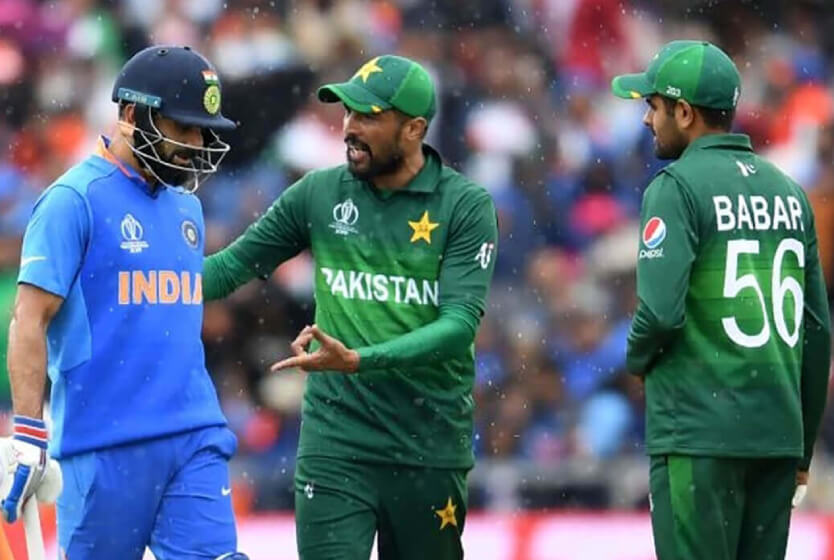
What Can Babar & Kohli Learn From Each Other?
In T20 cricket, both batsmen have different styles and approaches to the game. What can they learn from each other to improve?
During the 2017 Champions Trophy, the ICC released an interview with Babar Azam where the then 22-year-old mentioned that he wanted to become the number 1 ODI batsman in the world. Just under four years later, Pakistan’s talisman has usurped the Indian batting star at the top of the ICC rankings. Naturally, this invited a flurry of interesting ‘interactions’ between vocal Indian and Pakistani cricket fans around the world.
Notwithstanding emotional arguments and virtual fights over the internet, the respective captains of Team India and Team Pakistan respect each other. Babar recently revealed that one thing that helped him get to where he is today is to take net sessions seriously. Moreover, this was on the advice of a certain Indian batting legend – none other than Kohli himself.
However, in a T20 World Cup year, the world’s focus is on T20 and T20I cricket. Fittingly, both Babar and Kohli won the Player of the Series awards in their last T20I series – against South Africa and England. Since all the focus is on T20s nowadays, we’re going to focus on this format and see what both stalwarts can learn from each other and how they can improve their respective games.
T20s Since 2019
Since 2019, both batsmen have amassed more than 5000 runs in T20 cricket, with Babar responsible for the larger chunk of that total. Kohli has played only T20Is and IPL in this period, while Babar has played T20Is, PSL, England’s T20 Blast, and domestic competition National T20 Cup.
The usual caveats apply: Since Kohli only plays T20I and IPL, he generally faces stronger bowling sides than Babar, with the T20 Blast and National T20 Cup not offering up bowling attacks found in the highest level of franchise cricket. Still, a large sample size tells us about their respective game plans and capabilities.
(All numbers in this article are for post-2019 – updated till April 17, 2021.
| Babar Azam | Virat Kohli | |
| Avg | 50.3 | 46.3 |
| SR | 138.6 | 137.3 |
| Dot % | 29.1% | 26.0% |
| BPD | 36.3 | 33.8 |
| BPB | 5.6 | 6.9 |
| Bdry % | 18.0% | 14.5% |
| NBSR | 74.5 | 82.0 |
Start of the Innings
There isn’t a huge difference in their SRs over the first ten balls on the face of it. Babar strikes at 124, while Kohli strikes at 116. Both start faster against pace than spin, with Kohli being a little slower against spin at the start (126/118 for Babar, 122/100 for Kohli).
However, the difference becomes more pronounced in T20Is over the same period. Babar strikes at 142 in his first ten balls, with a split of 147/127 against pace/spin. Meanwhile, Kohli strikes at 109 in his first 10 deliveries, with a split of 116/98 against pace/spin. The difference in Babar’s numbers for T20s vs. T20Is is possibly because he has often opened the batting alongside batsmen struggling to up the tempo in international cricket and has to take the initiative himself. However, in the PSL and T20 Blast, he has batted at the start alongside Colin Munro, Liam Livingstone, Sharjeel Khan, and Tom Banton, all batsmen naturally renowned for taking the game on.
The same aspects shine through in their powerplay numbers. Babar strikes at 129 in PPs vs. Kohli’s 125, but that changes to 136/112 in T20Is. The corresponding boundary rates are 20%/18% vs. 21%/14% for internationals.
| Babar Azam | Virat Kohli | |
| Starting SR (1st 10) | 124 | 116 |
| 1st 10 vs. pace | 126 | 122 |
| 1st 10 vs. spin | 118 | 100 |
| Powerplay SR | 129 | 125 |
| Boundary % | 20% | 18% |
Early Middle Overs
Top-order batsmen are notoriously difficult to dismiss in the period of overs 7-11, which is obvious here. Babar averages 90+ here in T20s, while Kohli also averages more than 60. However, Indian T20 enthusiasts often criticize Kohli for his approach here, and it’s obvious why. While Babar strikes at 130 in T20s from overs 7-11, Kohli’s SR is just 105.
The primary reason for Kohli’s slow output in this period is his boundary rate, which wilts to a miserly 6%, compared to Babar’s 13%. While Babar is better in this period, the best T20 batsmen nowadays are recognizing that this is a phase where they can get on top of the bowlers and attack, leading to higher boundary rates and strike rates.
Another reason for Kohli’s apparent struggles in the middle of the innings is his low SR against spin. Babar is striking at 137/136 against spin in T20s and T20Is since 2019. Meanwhile, Kohli’s SR is just 115/111. Getting out to spin isn’t an issue for either of them, with both averaging 50+ deliveries per dismissal against spin in T20s and even higher in internationals. This indicates perhaps a lack of intent from India’s captain to dominate the slower bowlers, with Babar hitting boundaries twice as often.
| Babar Azam | Virat Kohli | |
| Overs 7-11 Avg | 93 | 64 |
| Overs 7-11 SR | 130 | 105 |
| Boundary % | 13% | 6% |
| 7-11 SR vs. pace | 133 | 122 |
| 7-11 SR vs. spin | 128 | 103 |
Late Middle Overs
In the late middle overs (12-16), Babar ups the ante considerably, striking above 160 in T20s overall and above 155 in T20Is. He does this by upping his boundary rate, hitting around 20% of the balls he faces for boundaries. While he does this successfully in T20s while maintaining a low dismissal rate, he tends to be dismissed quicker in international cricket, due to which he hasn’t batted in the death overs in T20Is that often since 2019.
Kohli matches Babar in this period, with a low dismissal rate – having faced over 200 deliveries, he’s only been dismissed thrice in T20Is between overs 12 and 16, striking at close to 160. However, that approach doesn’t quite carry over to T20s. In the IPL, he’s been dismissed during this period ten times in under 200 deliveries, striking at just around 120. Overall, the boundary rate is below Babar’s output as well.
| Babar Azam | Virat Kohli | |
| Overs 12-16 Avg | 50 | 44 |
| Overs 12-16 SR | 163 | 142 |
| Boundary % | 21% | 13% |
| 12-16 BPB | 4.8 | 7.8 |
Finishing the Innings
This is the stage where India’s master of the chase really comes to the fore. Striking at 222, hitting 30% of the deliveries he faces for boundaries, and being dismissed once every 18 balls – these are elite numbers for a batsman in overs 17-20 in T20 cricket. There isn’t much variance when it comes to T20Is; the SR remains 220, but the balls per dismissal go up somewhat to 20. Kohli has been equally impressive at the death for India as he has been in the IPL for RCB.
Pakistan’s captain has improved a lot in recent times with his death overs batting. However, that has gotten him to a point where he is just about good in this period with a strike rate of 166, approximately an RPO of 10 vs. Kohli’s effort of 13.4. However, he fails to increase his boundary rate of 20% from the previous period, lacking that final push that Kohli has in his game. For T20Is, he has rarely been able to get to the last four overs, facing just 21 deliveries in overs 17-20 since 2019. Thus, most of this sample size is dependant on non-international cricket.
| Babar Azam | Virat Kohli | |
| Death Avg | 23 | 41 |
| Death SR | 166 | 223 |
| Death BPD | 14 | 18 |
| Boundary % | 21% | 30% |
| Death BPB | 4.9 | 3.3 |
Weaknesses
Neither of the two batsmen has any major glaring holes in their match-ups – except for Kohli’s low average against left-arm pace. Since 2019, India’s captain averages 24 against left-arm pace in T20s and falls every 16.6 deliveries he faces from this bowling type. Against all other types of bowling, he averages 48 or higher. One other possible chink in his armor is facing leg-spin early on – a tactic England recently employed in the T20I series against India.
Babar’s lowest average against any bowling type is 46 against right-arm pace. With a larger sample size of his entire T20I career, the trend continues. Teams’ best bet is to use match-ups, i.e., spinners who turn the ball away from him to keep him quiet. However, he hasn’t shown any major propensity to being dismissed easily – until he gets to the death overs.
Before the death overs, i.e., overs 17-20, Babar Azam has an average of 56 with an SR of 137 since 2019. The corresponding numbers for Virat Kohli are 48/124. It’s in the death overs where the Indian captain turns the tables with incredible displays of controlled power-hitting.
Takeaways
Kohli has received a lot of criticism from Indian batting enthusiasts for his approach to the game. The Delhi-born batsman clearly possesses the ability to increase his output. However, he perhaps tends to opt for a more conservative batting approach to give himself the maximum chance of finishing the innings with a bang.
Critics would do well to remember that this is a man who was the Player of the Series in the T20 World Cup not once but twice – in 2014 and 2016. However, now the onus will be on India to go all the way, with a strong overall team on paper, including a varied and effective bowling attack.
Being six years younger, Babar has time on his side. All the numbers also show that he has an excellent all-round game, except that death overs acceleration. Perhaps Pakistan not being considered one of the favorites for the T20 World Cup may mean lesser pressure than for Kohli at the T20 World Cup later this year. However, Pakistan cricket doesn’t work that way – the pressure is an ever-present factor. Good displays get immense appreciation, but at the same time, the knives are always around when things go wrong. No pressure!







Leave a Reply